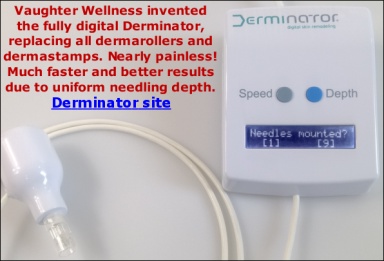Dermarolling / Microneedling / Oil cleansing method to get rid of blackheads
« on: August 09, 2011, 03:09:14 PM »- Steam your face to open up your pores or do it at the end of a hot bath.
- Pour some oil of your choice (test several to find the best working one for you) into a cup and warm it "au-bain-Marie" (place the cup inside a pan of hot water), we need nicely warm oil. If you have a product with salicylic acid, add it to the oil.
- Apply a lot of oil to your face and massage it in for 10-15 minutes or longer.
- Wet a clean cloth with warm water and start wiping the oil off to loosen up the pore plugs that are now very soft.
- If you are still too oily, clean the skin with a product that you normally use to clean your skin.
- If your skin is very tough, you can use Scotch tape (wipe the oil off first) to pull the plugs out. Do it very gently. No abrupt movements with the tape. Do not use a tape if you are on Accutane or have very sensitive or thin skin.
- Rinse your face with very cold water to close the pores.
The best product to use for this method is an ointment with salicylic acid. Salicylic acid penetrates the pores. Make it liquid in the microwave but pour it into a cup first because any metal in a microwave causes fire and can damage the microwave. Salicylic acid is oil-soluble and it will add to the dissolving ability of the oil to unclog the pores. Such ointments are sold for psoriasis or callus foot heels.
Oil cleansing method may cause breakouts in some individuals. You have to test it.
Repeated use is necessary to fully unclog the pores and maintenance is necessary.
If you clean your pores, they may slightly shrink in size.
Salicylic acid is the best for acne and blackheads-prone skin because it has a comedolyitic (de-clogging) effect. It penetrates the pores and disrupts the sebum that plugs them. There is a popular myth that blackheads consist of dirt and they are caused by poor hygiene. Blackheads are in fact a mixture of sebum (oily substance produced by sebaceous glands inside the pore) and keratin (a tough, protective protein in the outer layer of the skin). The dark color of blackheads is due to accumulated melanin pigment deposition. Melanin is a pigment normally present in the skin, making up our skin color. The blackheads are only pigmented at the tip.
To get rid of blackheads, you have to soften the keratin-sebum mixture. It is not an easy task. Keratin is very strong and tough material. In combination with oily sebum, it basically forms "glue" that plugs the pore. Keratolytics are substances that soften keratin. Salicylic acid is a keratolytic. Prolonged exposure to warm water also softens keratin however, oily sebum repulses water, and moreover you cannot dissolve the plugs with water or soap.
Salicylic acid is oil-soluble (contrary to glycolic acid and other Alpha Hydroxy Acids) and therefore can penetrate the oily pore and soften the plug. Prolonged contact with the skin is needed. Cleaning the skin with a product containing salicylic acid is good but not enough. Every now and then, you have to apply a higher percentage of salicylic acid, massage it into the pores and leave it on the skin for an hour or longer.





